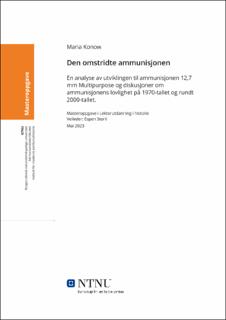| dc.contributor.advisor | Storli, Espen | |
| dc.contributor.author | Konow, Maria | |
| dc.date.accessioned | 2023-07-15T17:19:19Z | |
| dc.date.available | 2023-07-15T17:19:19Z | |
| dc.date.issued | 2023 | |
| dc.identifier | no.ntnu:inspera:144861905:37614025 | |
| dc.identifier.uri | https://hdl.handle.net/11250/3079348 | |
| dc.description.abstract | Ammunisjonen 12,7 mm Multipurpose, også kalt Raufoss eller Mk211, er en omstridt ammunisjon. Gjennom flere tiår er det stilt spørsmål om ammunisjonens lovlighet, og den har ved flere anledninger blitt kritisert for å stride mot krigens folkerett. Ammunisjonen ble utviklet på 1970-tallet på Raufoss, og ble raskt en suksess på grunn av dens egenskaper. Problemet er at flere av egenskapene også medførte at ammunisjonen ble kontroversiell. Historien til 12,7 mm Multipurpose er en historie om hvordan en suksessfull ammunisjon, tilpasset et ønsket formål også kan bli misbrukt og dermed også kritisert. Denne masteroppgaven tar for seg innovasjonsprosessen til 12,7 mm Multipurpose og hvorfor den ble en suksess, og videre hvordan suksessen ble fulgt av kritikk.
På Raufoss Ammunisjonsfabrikker ble det diskutert om 12,7 mm Multipurpose-ammunisjonen stred mot folkeretten før den ble produsert. Dette ble diskutert opp mot internasjonale diskusjoner om innstramninger av våpenforbud og krigens folkerett i diplomatkonferansene i Genève 1974-1977, kalt The Diplomatic Conferences on Reaffirmation and Development of International Humanitarian Law Applicable in Armed Conflicts. Stred ammunisjonen mot krigens folkerett eller de potensielle nye tilleggene? Konklusjonen til Raufoss Ammunisjonsfabrikker var at den ikke gjorde det ettersom ammunisjonen skulle brukes mot materielle mål. To tiår senere, i siste halvdel av 1990-tallet, ble ammunisjonen igjen kritisert for å stride mot krigens folkerett. Denne gangen var det Den Internasjonale Røde Kors Komité (ICRC) som startet diskusjonene, og utførte tester på ammunisjonen. Årsaken til at ammunisjonen ble kritisert var at den ble brukt mot menneskelige mål. Ammunisjonen var fra produsenten sin side kun ment til bruk mot materielle mål, men det at den ble brukt mot personell gjorde ammunisjonen kontroversiell. I 2003 ble 12,7 mm Multipurpose og usikkerheten rundt dens lovlighet et tema i Norge gjennom en rekke avisartikler. Disse avisartiklene og diskusjonene rundt ammunisjonens lovlighet førte til et forslag i Stortinget om eksportforbud av ammunisjonen, som ble nedstemt. Gjennom historien til ammunisjonen 12,7 mm Multipurpose får man et innblikk noen av utfordringene som følger utviklingen av ny teknologi i våpenindustrien, suksess blir ofte fulgt av kritikk. | |
| dc.description.abstract | The ammunition 12.7 mm Multipurpose, also called Raufoss or Mk211, is a controversial ammunition. For several decades, questions have been raised about the ammunition's legality, and it has faced criticism on several occasions for being in violation of the international humanitarian law. The ammunition was developed in the 1970s at Raufoss and quickly became a success due to its high-performance properties. The problem is that several of these properties also led the ammunition to become controversial. The history of 12.7 mm Multipurpose is a history of how a successful ammunition, intended for a specific purpose, can be misused, and consequently criticized. This master's thesis investigates innovation process behind 12.7 mm Multipurpose’s success and subsequent criticism.
Prior to 12.7 mm Multipurpose’s production, staff at Raufoss Ammunisjonsfabrikker, discussed whether the ammunition violated international law. These discussions were in relation with an international debate about tightening of arms embargoes, and a diplomatic conference regarding the international humanitarian law in Geneva 1974-1977, called The Diplomatic Conferences on Reaffirmation and Development of International Humanitarian Law Applicable in Armed Conflicts. Did the ammunition violate the international law of war or its possible new provisions? Raufoss Ammunisjonsfabrikker’s conclusion was that it did not, as the ammunition was to be used against material targets. Two decades later, in the latter half of the 1990s, the ammunition was again criticized for violating the international law of war. This time it was the International Committee of the Red Cross (ICRC) that started the discussions and carried out tests of the ammunition. The reason for the criticisms was the ammunition’s reported use against human targets. According to the manufacturer, the ammunition was intended for use against material targets only, but this misapplication generated controversy. In 2003, the 12.7 mm Multipurpose and the uncertainty surrounding its legality became a topic in Norway through a series of newspaper articles. These newspaper articles and the debate surrounding the ammunition's legality led to a failed vote in the Norwegian Parliament to ban its export. The history of the ammunition 12.7 mm Multipurpose gives insight into some of the challenges that accompany the development of new technologies in the arms industry; success is often followed by criticism. | |
| dc.language | nob | |
| dc.publisher | NTNU | |
| dc.title | Den omstridte ammunisjonen: En analyse av utviklingen til ammunisjonen 12,7 mm Multipurpose og diskusjoner om ammunisjonens lovlighet på 1970-tallet og rundt 2000-tallet. | |
| dc.type | Master thesis | |
